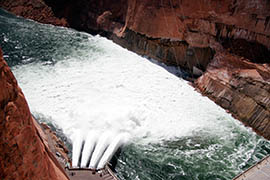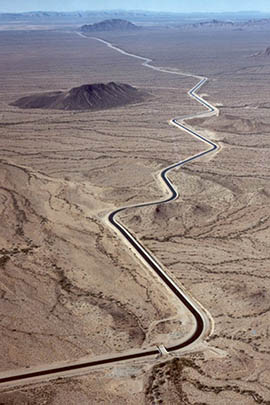
Rancher Cliven Bundy was disputing the federal government's claim he owed about $1.1 million in unpaid grazing fees from federal land his cattle was using. (photo: Jim Urquhart/Reuters)
 ell, I want to tell you one more thing I know about freeloading racist dumbasses.
ell, I want to tell you one more thing I know about freeloading racist dumbasses.Assuming that Adam Nagourney doesn't have mad wiretapping skillz of which I was not aware, or that he is not capable of the average Vulcan Mind Meld, ol' Cliven Bundy, the Paul Revere of the Hoveround militia, beloved grandpappy of the Traffic On The Three's First Vicarious Division, knew full well he was talking to a New York Times reporter when he decided to gleefully set the kitty free from the burlap.
"I want to tell you one more thing I know about the Negro," he said. Mr. Bundy recalled driving past a public-housing project in North Las Vegas, "and in front of that government house the door was usually open and the older people and the kids - and there is always at least a half a dozen people sitting on the porch - they didn't have nothing to do. They didn't have nothing for their kids to do. They didn't have nothing for their young girls to do. "And because they were basically on government subsidy, so now what do they do?" he asked. "They abort their young children, they put their young men in jail, because they never learned how to pick cotton. And I've often wondered, are they better off as slaves, picking cotton and having a family life and doing things, or are they better off under government subsidy? They didn't get no more freedom. They got less freedom."
If anything were ever About Race, I might say that ol'
Cliven was engaging is some racism right here, but since nothing is
ever About Race in this country, I must be mistaken, because Cliven is
all about freedom and liberty and the ancestral rights his family has to
The Land that date back to shortly after the Truman Administration. How
do you like your blue-eyed boy now, Mr. Hannity?
Let us leave the dusty plains of Camp Moocher for a moment and check back in with Jayson Veley, the shy and retiring Coldplay avatar from Eastern Connecticut State who was so crushed by his creative writing professor's suggestion that people like Cliven Bundy, and his enablers in conservative politics far and wide, might be stopping by the Nathan Bedford Forrest Rest Area on Liberty Highway that he felt compelled to tape the professor surreptitiously. Jayson, you may recall, was said to be so upset that he "wished to remain anonymous" while finking on his teacher. This lasted until Megyn Kelly batted her eyes at him and dragged young Jayson gleefully into the spotlight. What are we to make of our reluctant freedom fighter?
Well, it turns out there's more to Jayson than meets the eye. Oh, he's quite the aspiring little wingnut, our Jayson is.
Let us leave the dusty plains of Camp Moocher for a moment and check back in with Jayson Veley, the shy and retiring Coldplay avatar from Eastern Connecticut State who was so crushed by his creative writing professor's suggestion that people like Cliven Bundy, and his enablers in conservative politics far and wide, might be stopping by the Nathan Bedford Forrest Rest Area on Liberty Highway that he felt compelled to tape the professor surreptitiously. Jayson, you may recall, was said to be so upset that he "wished to remain anonymous" while finking on his teacher. This lasted until Megyn Kelly batted her eyes at him and dragged young Jayson gleefully into the spotlight. What are we to make of our reluctant freedom fighter?
Well, it turns out there's more to Jayson than meets the eye. Oh, he's quite the aspiring little wingnut, our Jayson is.
For years, we have seen a decline in small government republicanism among the youth. Junior Factor Nation believes that this is primarily due to liberal indoctrination in high school and college classrooms, as well as over-exposure to liberal philosophies from television and the media. As a result, we are seeing an increasing trend towards liberalism, atheism, and big government ideologies. The problem with this is that liberal policies are not in line with our founding principles. Therefore, if we allow this trend to continue, future generations may not even know the true meaning of the words "we the people." That is our battle - to ensure that our children grow up with just as much, if not more, freedom than we have in America today. It is time for a revolution of the heart and mind, and Junior Factor Nation is prepared to bring that revolution to light, one broadcast at a time.
Here are the rest of the Teen Titans.
(I don't know which is my favorite. The one who "rights article", or
the one who am very opinionated.) Wait a second, here's our boy.
Jayson Veley started his broadcasting career in July of 2009 with The Junior Factor, a local access television show that he co-hosted with his friend, Connor Mullin. The goal of The Junior Factor was to spread the conservative message to as many members as the youth as possible and aired for a total of three years, ending in the summer of 2012. Shortly after, Veley took on an even bigger project - a network called Junior Factor Nation which he co-founded with Caiden Cowger. The network consists of several different conservative radio programs, all hosted by kids in their teens and early twenties. Veley's show, Factor Talk Radio, started on April 26th, 2012 and currently airs from 7-8 PM on Monday and Thursday nights. Each broadcast features in depth conservative commentary, political analysis, humor, and of course, sarcasm, In the past, Veley has been criticized for being too aggressive on the air, but what some call anger he likes to call passion. The future of America is at stake, and if it's a war the liberals want, it's a war they're going to get.
Not actual war, of course. That's for suckers without
their own cable-access programs. Anyway, Jayson seems to have a rather
elastic concept of "anonymity."
(And, not for nothing, but Jayson also has a few thoughts on The Negro that he'd like to share.)
(And, not for nothing, but Jayson also has a few thoughts on The Negro that he'd like to share.)
The point of it all is to point out (again) that there is a very sophisticated propaganda operation being conducted on one side of the political debate. Once you wander into that world, you notice that almost everything is a shuck. It's a completely artificial universe that has unfortunate real-world consequences for the rest of us. Nothing there is ever truly what it seems and P.T. Barnum was born a couple centuries too early.





 s
Congress returned from a two-week recess, more than 1,500 people
gathered at the Capitol to protest the growing chasm between rich and
poor Americans, calling on Congress to stand with everyday people
instead of corporate special interest groups. Immediate demands included
a raise in the minimum wage and cuts to corporate tax breaks, both key
causes of rising economic inequality and the result of Congressional
lawmakers who cater to out of control corporate interests.
s
Congress returned from a two-week recess, more than 1,500 people
gathered at the Capitol to protest the growing chasm between rich and
poor Americans, calling on Congress to stand with everyday people
instead of corporate special interest groups. Immediate demands included
a raise in the minimum wage and cuts to corporate tax breaks, both key
causes of rising economic inequality and the result of Congressional
lawmakers who cater to out of control corporate interests.


 early
60% of China’s underground water is polluted, state media has reported,
underscoring the severity of the country’s environmental woes.
early
60% of China’s underground water is polluted, state media has reported,
underscoring the severity of the country’s environmental woes.






 he evidence of income inequality just keeps mounting. According to “
he evidence of income inequality just keeps mounting. According to “




